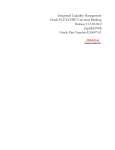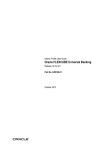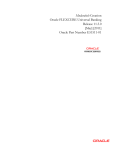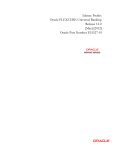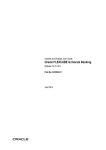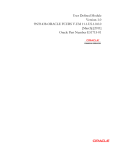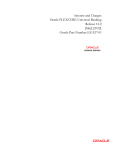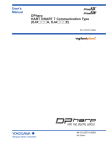Download Islamic Integrated Liquidity Management User Manual
Transcript
Islamic Integrated Liquidity Management Oracle FLEXCUBE Universal Banking Release 12.0 [May] [2012] Oracle Part Number E51527-01 Integrated Liquidity Management Table of Contents 1. ABOUT THIS MANUAL................................................................................................................................ 1-1 1.1 1.2 1.3 1.4 1.5 2. ISLAMIC INTEGRATED LIQUIDITY MANAGEMENT - AN OVERVIEW ........................................ 2-2 2.1 3. INTRODUCTION ........................................................................................................................................... 1-1 AUDIENCE .................................................................................................................................................. 1-1 ORGANIZATION .......................................................................................................................................... 1-1 RELATED DOCUMENTS ............................................................................................................................... 1-2 GLOSSARY OF ICONS .................................................................................................................................. 1-2 INTRODUCTION ........................................................................................................................................... 2-2 MAINTAINING PARAMETERS FOR ISLAMIC INTEGRATED LIQUIDITY MANAGEMENT ..... 3-1 3.1 INTRODUCTION ........................................................................................................................................... 3-1 3.2 MAINTAINING ACCOUNT CLASSES ............................................................................................................. 3-2 3.3 MAINTAINING SDES ................................................................................................................................... 3-3 3.4 MAINTAINING UDES .................................................................................................................................. 3-4 3.5 CREATING PROFIT & CHARGES RULES ....................................................................................................... 3-4 3.5.1 Creating Profit & Charges Products ................................................................................................. 3-5 3.5.2 Maintaining IP Special Conditions for Customer Accounts .............................................................. 3-6 3.6 MAINTAINING PRODUCT EVENT CLASS & ACCOUNTING ENTRIES ............................................................. 3-8 3.6.1 Defining Accounting Entries for Event .............................................................................................. 3-9 3.6.2 Associating Branch to Event Class .................................................................................................. 3-10 3.7 GROUP CODE MAINTENANCE ................................................................................................................... 3-11 3.7.1 A Note on Back Valued Transactions .............................................................................................. 3-13 3.8 MAINTAINING ACCOUNT STRUCTURES .................................................................................................... 3-14 3.8.1 Indicating Account Details .............................................................................................................. 3-15 3.8.2 Maintaining Sweeping Parameters .................................................................................................. 3-16 3.8.3 Closing Accounts in an Account Structure ...................................................................................... 3-17 3.8.4 Creating Group Account Linkages .................................................................................................. 3-19 4. BATCH MAINTENANCE ............................................................................................................................. 4-1 4.1 4.2 4.3 4.4 4.5 4.6 5. INTRODUCTION ........................................................................................................................................... 4-1 MAINTAINING EOD BATCH ........................................................................................................................ 4-1 MAINTAINING MANDATORY PROGRAM FOR IIBATCH DURING END OF TRANSACTION INPUT .................. 4-1 MAINTAINING MANDATORY PROGRAM FOR IPEOD DURING END OF TRANSACTION INPUT ...................... 4-3 MAINTAINING MANDATORY PROGRAM FOR IIBATCH DURING BOD ....................................................... 4-4 MAINTAINING MANDATORY PROGRAM FOR IPEOD DURING BOD: ........................................................... 4-5 BATCH PROCESS.......................................................................................................................................... 5-5 5.1 INTRODUCTION ........................................................................................................................................... 5-5 5.2 INTRADAY BATCH PROCESSING.................................................................................................................. 5-5 5.3 END OF DAY PROCESSING .......................................................................................................................... 5-5 5.3.1 Generating System Accounts.............................................................................................................. 5-2 5.3.2 Sweeping ............................................................................................................................................ 5-3 5.3.3 Batch process for Sweep Eligible Balance ........................................................................................ 5-3 6. IP BATCH PROCESSING ............................................................................................................................. 6-4 6.1 INTRODUCTION ........................................................................................................................................... 6-4 6.2 IP PROCESSING FOR ACCOUNT STRUCTURES .............................................................................................. 6-4 6.2.1 Processing Profit Distribution ........................................................................................................... 6-2 7. REPORTS ........................................................................................................................................................ 7-9 7.1 INTRODUCTION ........................................................................................................................................... 7-9 7.2 ACCOUNT STRUCTURE REPORT .................................................................................................................. 7-9 7.2.1 Report Options ................................................................................................................................... 7-9 7.2.2 Contents of the Report ....................................................................................................................... 7-2 8. ANNEXURE A - ACCOUNTING ENTRIES ............................................................................................... 8-2 8.1 ACCOUNTING ENTRIES FOR ILM ................................................................................................................ 8-2 8.2 EVENTS ...................................................................................................................................................... 8-2 8.3 EVENT-WISE ACCOUNTING ENTRIES FOR PRODUCTS.................................................................................. 8-2 8.3.1 Pool Header Product ......................................................................................................................... 8-2 8.3.2 Pool Reallocation Product................................................................................................................. 8-3 8.3.3 Sweep and Reverse Sweep ................................................................................................................. 8-4 ANNEXURE B – IP RULE SET-UP .............................................................................................................. 9-1 9. 9.1 INTRODUCTION ........................................................................................................................................... 9-1 9.2 IC RULE MAINTENANCE ............................................................................................................................. 9-1 9.2.1 Pool Header ....................................................................................................................................... 9-2 9.2.2 Pool Reallocation .............................................................................................................................. 9-6 9.3 UDE VALUE MAINTENANCE .................................................................................................................... 9-10 10. 10.1 SCREEN GLOSSARY .............................................................................................................................. 10-1 FUNCTION ID LIST.................................................................................................................................... 10-1 1. About this Manual 1.1 Introduction This manual is designed to help acquaint you with the Islamic Integrated Liquidity Management module of Oracle FLEXCUBE. This manual provides answers to specific features and procedures that you need to be aware of for the module to function successfully. Besides this User Manual, while maintaining the interface related details, you can invoke the context sensitive help available for each field. This help encapsulates the purpose of each field within a screen. Placing the cursor on the relevant field and striking the <F1> key on the keyboard can obtain information specific to a particular field. 1.2 Audience This manual is intended for the following User/User Roles: Role Function Back office data entry Clerks Input functions for maintenance related to the interface. Back office Managers/Officers Authorization functions 1.3 Organization This manual is organized into the following chapters: Chapter 1 About this Manual gives information on the intended audience. It also lists the various chapters covered in this User Manual. Chapter 2 Integrated Liquidity Management - An Overview offers an introduction to the module and its features. Chapter 3 Islamic Integrated Liquidity Management Maintenance explains how to maintain certain parameters before defining account structures for integrated liquidity management process. Chapter 4 Batch Maintenance explains the Batches that need to be maintained for II Chapter 5 Batch processing explains various processes related to batches maintained for the Islamic Liquidity Management Chapter 6 IP Batch Processing explains about the process involved in IP batch Chapter 7 Reports give a detailed account of report generation from this module and the contents of such reports. Chapter 8 Annexure A – Lists the Accounting Entries for Profit and Charge Product applicable for the Integrity Liquidity Management module. Chapter 9 Annexure B – Lists the Profit and Charge rules that need to be maintained for the Islamic Integrity Liquidity Management module. 1.4 Related Documents The Procedures User Manual 1.5 Glossary of Icons This User Manual may refer to all or some of the following icons: Icons Function Exit Add row Delete row Option List 2. Islamic Integrated Liquidity Management - An Overview 2.1 Introduction Liquidity Management refers to the services your bank provides to its corporate customers thereby allowing them to optimize profit on their checking/current accounts by sweeping funds from different accounts. Your corporate customers can, therefore, manage the daily liquidity in their business in a consolidated way. Customers need to define ‘account structures’ which form the basis of liquidity management. The account structure reflects the hierarchical relationship of the accounts as well as the corporate strategies in organizing accounts relationships. Islamic liquidity management supports sweeping funds. Sweeping is the process where physical funds are moved in account structure from child to parent or parent to child. The Islamic Integrated Liquidity Management (ILM) module in Oracle FLEXCUBE supports a multi-branch, multi-currency liquidity management structure using architecture of ‘System Accounts’. This enables the system to keep track of balances in accounts in the structure, calculate profit on the accounts in the structure as well as track the history of the sweep structure. System accounts are internal accounts created by the system based on the role played by an account in an Account Structure. This document is broadly classified into two sections as follows: Maintenance required for ILM EOD Batch operations and sequenc 2-2 3. Maintaining Parameters for Islamic Integrated Liquidity Management 3.1 Introduction You need to maintain certain parameters before you define account structures for integrated liquidity management process. They are: Account class IC – SDE Maintenance IP Rule Maintenance IP Product Maintenance Customer Maintenance Islamic Account Maintenance Transaction Code Product Event class and Accounting entries for ILM ILM Branch parameters Maintenance Group Code Maintenance Account Structure Maintenance Group Account Linkage Other Maintenances 3-1 3.2 Maintaining Account Classes You can use the Account Class feature in Oracle FLEXCUBE to create a set of accounts which have the same characteristics. You can invoke the ‘Account Class Maintenance’ screen by typing ‘IADACCLS’ in the field at the top right corner of the Application tool bar and clicking on the adjoining arrow button. Click on the ‘Preferences’ button in the ‘Account Class Maintenance’ screen to invoke the ‘Preferences’ screen. You are required to input the following details in this screen: Integrated Liquidity Management Check this option to indicate that accounts created under this Account Class should be part of an ILM Structure. If the option is checked, the system creates system accounts (internal accounts) for each account that is linked in a sweep structure and tracks the balances on both the actual accounts as well as these system accounts. It also calculates profit on these system accounts. Profit on accounts that are not part of an account structure are calculated on the actual customer account. 3-2 3.3 Maintaining SDEs In order to calculate Profit, Oracle FLEXCUBE uses components called ‘data elements’ that provide the required data. System Data Elements (SDEs) are values such as the balance in an account or the number of transactions in a day. This information is constantly updated in the system and is readily available for computation of Profit. These values can only be picked up by the system while applying Profit. User cannot indicate what the value of an SDE should be. The following SDEs will be used in IC Processing: SDE (System Data Elements) Description ILBD_ULT_DR_BAL Captures the book dated Debit balance of the pool header in this Data element during the IC calculation process ILBD_ULT_CR_BAL System populates the book dated Credit balance of the pool header in this data element during the IC calculation process ILVD_ULT_DR_BAL System populates the value dated Debit balance of the pool header in this data element during the IC calculation process ILVD_ULT_CR_BAL System populates the value dated Credit balance of the pool header in this variable during the IC calculation process ILBD_CP_DR_CONT This data element captures the Compensated contribution of the book dated Debit balance ILBD_CP_CR_CONT This data element captures the Compensated contribution of the book dated Credit balance ILVD_CP_DR_CONT This data element captures the Compensated contribution of the value dated Debit balance ILVD_CP_CR_CONT This data element captures the Compensated contribution of the value dated Credit balance ILBD_NCP_DR_CONT This data element captures the Non Compensated contribution of the book dated Debit balance ILBD_NCP_CR_CONT This data element captures the Non Compensated contribution of the book dated Credit balance ILVD_NCP_DR_CONT This data element captures the Non Compensated contribution of the value dated Debit balance ILVD_NCP_CR_CONT This data element captures the Non Compensated contribution of the value dated Credit balance 3-3 3.4 Maintaining UDEs User Data Elements (UDEs) are elements (such as Profit or Tax rate) the values for which are provided by the User. The following User Data Elements (UDE) can be specified in IP Rule Maintenance: Debit Rate for Sweep Balance Credit Rate for Sweep Balance Inter-Bank Rate Tax Rate 3.5 Creating Profit & Charges Rules You can use the SDEs and UDEs that you have previously defined to create formula to be used by the system for Profit calculations in the ‘Profit & Charges Rule Maintenance’ screen. You can invoke the ‘Profit & Charges Rule Maintenance’ screen by typing ‘IPDRLMNT’ in the field at the top right corner of the Application tool bar and clicking on the adjoining arrow button. You are required to input the following detail in this screen: Integrated LM Choose this option if you want to use the product for Integrated Liquidity Management processing. 3-4 Integrated LM Type Specify the type of System Account to which the product ought to be linked. It can be: Pool Leader: Indicates that the Rule will apply to Header accounts in a structure. Pool Reallocation: Indicates that the rule will apply to Parent and Child Accounts below the Header Account. Refer the chapter ‘Annexure B – IC Rule Set-up’ in this User Manual for suggested IC rules. 3.5.1 Creating Profit & Charges Products You can invoke the ‘Profit And Charges – Profit Product Preferences’ screen by clicking ‘Preferences’ button on the ‘Profit And Charges Product Maintenance’ screen. You can invoke the latter by ‘typing ‘IADPRMNT’ in the field at the top right corner of the Application tool bar and clicking on the adjoining arrow button. 3-5 You can input the following details in this screen: Integrated LM Product Choose this option if you want to use the product for Integrated Liquidity Management processing. Integrated LM Type Specify the type of System Account to which the product ought to be linked. It can be: Pool Leader: Indicates that the Rule will apply to Header accounts in a structure. Pool Reallocation: Indicates that the rule will apply to Parent and Child Accounts below the Header Account. Refer the chapter ‘Annexure A - Accounting Entries’ in this User Manual for suggested IC products. 3.5.2 Maintaining IP Special Conditions for Customer Accounts The ‘Islamic Accounts Maintenance’ screen is used to create accounts for a given Customer using the desired account class and currency combination. You can invoke the ‘Islamic Accounts Maintenance’ screen by typing ‘IADCUSAC’ in the field at the top right corner of the Application tool bar and clicking on the adjoining arrow button. Click ‘Profit’ button in ‘Customer Account Maintenance’ screen to invoke ‘IP Special Conditions Maintenance’ sub-screen, where you can maintain IP special conditions for ILM accounts. 3-6 ILM accounts need to be created with special conditions by attaching the products with effective date and UDE values. 3.5.2.1 IP Special Conditions The system displays the following fields on the basis of your choice in the IP Rule and IP Product screens. Integrated LM The system defaults the value specified in the product screen from based on product selected from the option list. 3-7 Integrated LM Type The system displays the value on the basis of your choice in the IP Rule and IP Product screens. 3.6 Maintaining Product Event Class & Accounting Entries When you define an Events Class, you choose, first of all, the set of events that would belong to the class. Events are, usually, unique to a module. The events that you would like to include in an Events Class can be identified through the ‘Events Accounting Entries and Advices Class Maintenance’ screen. This screen is invoked from the Application Browser. You can invoke the ‘Events Class Maintenance’ screen by typing ‘CSDACTCL’ in the field at the top right corner of the Application tool bar and clicking on the adjoining arrow button. You can maintain the following details in this screen: Class Code An Events Class is identified with a unique Code and a Description. This indicates the name of the event class to which the events for ILM processing will be linked. Description You need to enter a brief description for the class code. Module Events are, usually, unique to a module. Specify the module as IL to define the events for Islamic Liquidity Management module. 3-8 Event Code Specify a valid code for the event you need to maintain. The adjoining option list displays all valid codes maintained for IL events. You can select the appropriate one. Event Description Once you specify the class code and module, click on add icon. The system will display the events associated with the Integrated Liquidity Management module. The following events are available for the integrated liquidity management module: SWBK : Sweep Booking RVSW: Reverse of Sweep Booking RALL: Reverse ALL (Book / Reverse Sweep) 3.6.1 Defining Accounting Entries for Event You can indicate the accounting entries that should be passed at an event in the Accounting Entries section of the ‘Events Class’ screen. This section is invoked by clicking the ’Accounting Entries’ button. As part of the Accounting Entry details of an event, you should specify the following details: The accounting role The amount tag If a debit or a credit The transaction code Accounting Role If accounting entries are to be passed for an event, you have to indicate the different Accounting Roles. At an event in the life cycle of a deal, involving a product to which you associate the class, the appropriate entries will be passed under the specified Accounting Roles. The adjoining option list displays a list of all the available accounting roles. Amount Tag The amount (i.e. the available balance, booking dated balance etc.) that is to be posted for an event, is referred to as the Amount Item. The tag associated with an Amount Item is the Amount Tag. The adjoining option list displays a list of the amount tags that are maintained in the system. You can choose a tag by double clicking on it. Debit/Credit You have already specified the type of account to which an entry should be passed, and the tag which identifies the amount (available balance, booking dated balance etc.) that should be passed. In this field, you must indicate if the amount is to be debited from credited to the specified account. Choose the Debit or Credit indicator. 3-9 Transaction Codes Every accounting entry in Oracle FLEXCUBE involves a Transaction Code that describes the nature of the entry. This code and its description will identify the original sweep book, reverse booking and their corresponding reversals. The Transaction Code for both legs of the transaction would be the same. The table below illustrates the accounting entries for each event that you need to set up for the liquidity management module. Event Debit/Credit Indicator Accounting Role Amount Tag SWBK DR CHILD CR_CONT SWBK CR PARENT CR_CONT SWBK CR CHILD DR_CONT SWBK DR PARENT DR_CONT RVSW DR PARENT CR_CONT RVSW CR CHILD CR_CONT RVSW DR CHILD DR_CONT RVSW CR PARENT DR_CONT Refer to the Modularity User Manual for further information on setting up accounting details. 3.6.2 Associating Branch to Event Class After you define the accounting entries that need to be passed for a set of events, you need to associate the event accounting entries to the branches of your bank. You can invoke the ‘ILM Branch Parameter Maintenance’ screen by typing ‘ILDBRPRM’ in the field at the top right corner of the Application tool bar and clicking on the adjoining arrow button. 3-10 For field details refer ‘Associating Branch to Event Class’ section in ‘Maintaining Parameters for Integrated Liquidity Management’ of IL module. Branch parameters maintained for IL modules is applicable for II module and the vice versa. Hence a single maintenance in any of the both modules is sufficient. 3.7 Group Code Maintenance In Oracle FLEXCUBE, you can bring together several accounts to form a ‘Group’ for ILM processing. You can then link this group code to the Header Account maintained as part of Account Structure. In Oracle FLEXCUBE, group codes allow you to uniquely identify a given account structure for ILM processing. You can invoke the ‘Integrated Liquidity Management Group Code Maintenance’ screen by typing ‘IIDGRPCD’ in the field at the top right corner of the Application tool bar and clicking on the adjoining arrow button. 3-11 You can input the following details in this screen: Group Code and Description Enter a unique code to identify the group code in the system. Enter a brief description. Effective Date Specify the date from which the group will become active in the system. You will not be allowed to input Back Valued Dates (BVT) here. Sweep Basis You need to indicate if the sweep should be performed on Book Dated balance or Value Dated Balance for the entire structure falling under the group. . If BVT support is required, it must have ‘Value Dated’ option. Pool Benefit If you select this option, profit re-allocation is carried out for the child accounts involved in the group. Reverse Sweep Indicate whether reverse sweeps should be performed during BOD batch. BVT Applicable Specify if BVT processing is applicable for a group 3-12 BVT Unit Indicate the unit the system should consider while calculating the BVT date. This can be Days/Months BVT Duration This indicates the number of BVT units allowed as back period from today’s date while calculating BVT date. For instance, to indicate 30 Days input ‘Days’ as BVT Unit and ‘30’ in the BVT Duration fields. Similarly, to indicate 2 months, the BVT Unit should be ‘Months’ and the BVT Duration ‘2’. Note the following: If the Sweep basis is Book Dated, back value dated transaction is not allowed. While maintaining a new Group, the system validates if ‘ILM Applicable’ check box is checked at the branch level. BVT is considered only from the same day, if it’s posted on working day. If it is posted on a holiday, then the system considers BVT from the next working day. The same is applicable for BVT entries entered by the system to the account. 3.7.1 A Note on Back Valued Transactions The system rebooks the sweeps (in case of physical pooling) and adjusts the profit amount that had been accrued and settled in the accounts when you input a transaction with a back value date. In case of a change in the Account Structure in the interim between the Back Value Transaction (BVT) date and current date, the system uses the account structure existing on the execution days. The following points need to be kept in mind for BVT Processing: It is performed only for sweeps which are value based. The corresponding System Account active on the Effective Date is considered for a back valued transaction to an account. (BVT for Islamic ILM is considered only when it is a working day) The processing involves replaying the sweep from the least date of the BVT which means that the Contributions and Pool Balances of the System Accounts are calculated afresh. The balances in all accounts of the structure are reworked and the sweeps carried out again for each of the previous sweep having the same value date. The value dated balances of the Parent Account as well as the Child Accounts in the Account Structure are updated In Customer Account Statements, only the back value transaction will be available on the date that it was posted. The system follows the following process for replaying sweeps: 1. It omits BOD processing for the least back value date only and continues till the current processing date. It then identifies the value dated balance of the current processing date for the corresponding System Account and carries out the EOD processing. 2. For a particular Effective Date, it calculates Sweep Amount for the corresponding System Accounts. 3-13 3. It fetches the entry posted for the BVT date from the Sweep Log and compares it with the Sweep Amount that has been calculated currently. 4. If the Sweep Amounts are equal, no entry is posted. 5. If the Sweep Amounts are different, it reverses the entry that was posted for the BVT date (SWBK) and the corresponding entry that was used during BOD to reverse the entry above Reverse sweep booking (RSBK) 6. Reversal of Reverse Sweep (RSWR) entry gets posted during reversal of RVSW. 7. It inputs a new entry whose booking date is the processing date of the BVT and whose value date is the BVT date. This entry is entered into the Daily Log. 8. It then updates the post sweep balances for a combination of Account + Effective Date + System Account. Every time a physical sweep is executed, the system stores the credit balance and the unused OD limit in the Parent Account before and after the sweep. 3.8 Maintaining Account Structures In Oracle FLEXCUBE, you can define a structure for the various accounts participating in the ILM process and set up a hierarchy for the accounts - establish the relationships or links among the accounts that are to be part of the Group. 3-14 You need to define the account structure and the hierarchy for ILM processing in the ‘Islamic Account Structure’ screen. You can invoke the ‘Account Structure Maintenance’ screen by typing ‘IIDSWEEP’ in the field at the top right corner of the Application tool bar and clicking on the adjoining arrow button. You can define the following parameters as part of maintaining the account structure for ILM processing: 3.8.1 Indicating Account Details Specify the following details. Account First, you need to specify the account (main or affiliate account) which has to be part of the account structure. Account Type You need to indicate whether the account that you have specified is a main account or secondary account. The account type defines the relationship between the accounts. Select the option ‘Parent’ to indicate that the account is the main account in the hierarchy. Select the option ‘Child’ to indicate that the account is a secondary account in the hierarchy. You will not be able to link the accounts at the same level in an account structure. If you de-link a parent account from a structure or link it to another parent in the same structure, the associated child accounts linked to it will also follow the parent account. 3-15 Effective Date You need to indicate the date from which the account structure is available in the system for ILM processing. Parent Account This is applicable only if you are maintaining a child account. You need to indicate the parent account for the child here. You cannot link a child account to more than one parent account. Booking Account You need to indicate the account to which the profit amount is to be booked during profit reallocation (after Profit is calculated). The booking account linked to the account should have the same currency as the account. Scheme Indicate the type of structure for which the link is being defined. The following types are possible: Sweep: Indicates that the level of the structure is Sweep, in which movement of funds is physical. Profit Reallocation Check this option to allow profit to be re-allocated to child accounts based on their contribution. 3.8.2 Maintaining Sweeping Parameters Specify the following details. Sweep Type This indicates the sweep type of the parent and child account. The sweep type can be either of the following: Debit (Sweep Out) Credit (Sweep In) Target Balance Agreement Base Amount The amount depends on the sweep type that you have selected. If the sweep type is Debit, the Amount indicates the balance in the account that should trigger a sweep out of funds. The sweep transaction will be executed if the balance in the account becomes greater than this amount. If the sweep type is Credit, the Amount indicates the balance in the account that should trigger a sweep in of funds. The sweep transaction will be executed if the balance in the account goes below this amount. If the sweep type is Target Balance, the Amount indicates the minimum balance that is to be left behind in the Child Account after the sweep is performed. A value of zero indicates Zero Balancing sweeps. 3-16 Multiples Amount This indicates the multiples amount in which the system performs sweeps. Example: Let us assume the following: Available amount in account: 900 Base Amount: 100 Multiples amount: 250 In this case, the system works out the amount to be swept as follows: 900 – ((mod (900 – 100) / 250) + 100) 900 – (50 + 100) = 750 3.8.2.1 Validating Account Structure The system validates the following for account structure: Account must not be linked to more than one Parent Account Account must not participate in another account structure with different header account There must not be any cyclic links in the structure Accounts that act as a Parent Account in the structure must be explicitly maintained with the account type as Parent Back Dated Structure Change is disallowed Accounts at the same level in the structure must not be linked If a Parent Account is delinked from a structure or linked to another parent in the same structure, then the Child Accounts linked to it must also be delinked or linked accordingly If ‘Scheme’ is maintained as ‘Sweep’, then the Parent Account and Child Account must be in the same currency Parent and Child Account in the account structure must be in the same fund ID Effective date of child must be greater than or equal to parent structure Base amount must not be assigned to parent structure 3.8.3 Closing Accounts in an Account Structure The following steps explain how to close an account in a given account structure. Let us assume that, in the structure shown below, we need to close account P2 and attach account C2 directly to H1. 3-17 The steps to be followed for the closure are: Child Account C2 is closed first (You can query to find out the child accounts of a given parent account, say P2 ) Subsequently, account P2 is closed. Account C2 is now freshly linked with H1. After the structure change has been carried out, the new structure appears as shown below: In the new structure (i.e. after the change), account C2 will have a new ‘System Account’ associated with it. BVT is not applicable for a group if any of the account structure closes and BVT falls in that period. 3-18 3.8.4 Creating Group Account Linkages You can link the account structure to the group codes that you have maintained in the ’Islamic Account Group Linkage Maintenance’ screen. You can invoke the ’Account Group Linkage Maintenance’ screen by typing ‘IIDGRPLN’ in the field at the top right corner of the Application tool bar and clicking on the adjoining arrow button. In this screen, you need to specify the following: Header Account The system will display the parent accounts maintained as part of account structure maintenance. Select the account which you want to link to the group. Effective Date Indicate the date on which the structure under the group should come into effect. Group Code Indicate the group code to which you want to link the account structure. 3.8.4.1 Validating Group Account Linkages The system validates the following for group account linkages: Modification of Account Group linkage is disallowed for an effective date If a record has to be closed, then the structure reporting to the group code must be validated. The structure must be linked to the new group code for the effective date greater than the closure date Group linkage effective date must be greater than or equal to Group code effective date 3-19 Effective date of Account structure related to group linkage must be greater than or equal to linkage effective date For example, the following structure may be defined for a Group Code ‘GRP’ HACC (Header Account) -- PACC1 (Child to HACC) -- CACC1 (Child to PACC1) -- PACC2 (Child to HACC) -- CACC2 (Child to PACC2) -- CACC3 (Child to PACC2) In the above structure, PACC2 is the Child Account in the link HACC – PACC2 whereas Parent Account in PACC2 – CACC. 3-20 4. Batch Maintenance 4.1 Introduction Apart from the maintenances mentioned in previous sections, Oracle FLEXCUBE enables you maintain Batch processes. This chapter provides an input on various batches maintained for the module. 4.2 Maintaining EOD Batch You are required to maintain the following sequence for ILM batches that need to be run, for any branch which is enabled for ILM. You can invoke the ‘Mandatory Batch Program Maintenance’ screen by typing ‘EIDMANPR’ in the field at the top right corner of the Application tool bar and clicking on the adjoining arrow button. At EOTI – Stage ILBATCH or IIBATCH (any one of them) – carries out both conventional and Islamic ILM processing IPEOD At BOD - Stage ILBATCH or IIBATCH – any one of them IPEOD Intra Day Batch IIINTSWP or ILINTSWP (any one of them) – carries out both conventional and Islamic ILM processing The various mandatory programs are show below: 4.3 Maintaining Mandatory Program for IIBATCH during End of Transaction Input IIBATCH processes the account structure based on the group code maintained at ‘Islamic Group Codes Maintenance’ level. This batch creates or updates the system accounts based on the account structure maintained for the ILM accounts. 4-1 4-2 4.4 Maintaining Mandatory Program for IPEOD during End of Transaction Input IPEOD batch calculates the profit for the CASA and system accounts for the Mudarabah rate computed by the PDM batch. IP batch should run only if IIBATCH is successful. Hence, in IPEOD mandatory program, you need to maintain the field predecessor as IIBATCH so that the IP Batch will not run if IIBATCH fails. 4-3 4.5 Maintaining Mandatory Program for IIBATCH during BOD 4-4 4.6 Maintaining Mandatory Program for IPEOD during BOD: 5. Batch Process 5.1 Introduction Each batch maintained in the previous section involves a unique process. The subsequent sections of this chapter explains the various processes related to batch (real time, intra day and end of day) maintained by the system as part of ILM processing. 5.2 Intraday Batch Processing A particular group code could be processed during intraday batch, post updates are disallowed to the account structure. After running intraday batch, the system will not generate group code during IIBATCH processing. 5.3 End of Day Processing 5-5 5.3.1 Generating System Accounts An account can play the role of child or parent in an account structure. For this purpose (and to help in the processing of corrections such as back value dated transactions), Oracle FLEXCUBE creates system accounts. This helps the system to identify the role of the account in a structure at any point of time. The resolution for generation of system accounts is as follows: The system identifies all the active groups in the branch to which the accounts are linked in Account Structure Maintenance. The system also identifies all the accounts in the Account Structure. The system identifies the ultimate parent account or Header Account linked to the group in a structure creates System Accounts for the given structure. The system accounts are created for every account. The system assigns level called System Account level apart from the level of the account in the structure that you have maintained. For instance, in the illustration explained under the section ‘Linking Account Structure to Group Code’, the Account Structure for the Group GRP is maintained as: Child Account Parent Account IL Relation HACC GRP C HACC HACC P PACC1 HACC C PACC2 HACC C PACC1 PACC1 P PACC2 PACC2 P CACC1 PACC1 C CACC2 PACC2 C CACC3 PACC2 C The System Account is created for the above mentioned Account Structure as follows: Account IL Relation As System Account Account Level System Account Level HACC Parent T3 2 1 HACC Header T4 2 2 PACC1 Child T1 2 3 PACC2 Child T2 2 3 5-2 Account IL Relation As System Account Account Level System Account Level PACC1 Parent S3 3 1 PACC1 Header S4 3 2 PACC2 Parent S6 3 1 PACC2 Header S7 3 2 CACC1 Child S1 3 3 CACC2 Child S2 3 3 CACC3 Child S5 3 3 The System Account will have the same account Class, currency and customer ID as that of the customer account. The attributes defined in the Account Structure Maintenance are carried forward for the corresponding System Accounts. 5.3.2 Sweeping During End of Day (EOD) process, you can execute the sweep process for integrated liquidity management. When you execute this process, based on your specifications, funds are swept between accounts in a structure. That is: In a multi-tiered sweep structure, sweeps of a lower level will be done before the sweeps of a higher level. System identifies the level of the System Accounts and the contribution of each account to its respective Pool is calculated. This information is stored at the Account + System Account + Effective Date level. For sweeping structures, system will also post accounting entries as follows: Dr Contributing Account Amount Cr Receiving Account Amount The value date and posting date for the entries will be the date on which the sweep is actually executed. If a sweep cannot be executed because of any reason, the system stores the information for reporting. 5.3.3 Batch process for Sweep Eligible Balance To determine the Contribution Amount, the ILM batch considers the Sweep Eligible Balance instead of the Available Balance. Example Account Balance: Sweep InEligible Balance: 2,000.00 500.00 5-3 Sweep Eligible Balance: 1,500.00 The Sweep Ineligible Balance is populated from E-Gifts DEUPLOAD interface based on the 'AIP Eligible' value as Y or N. Any record with 'AIP Eligibility' set to N increases the Sweep InEligible balance by that amount. 6. IP Batch Processing 6.1 Introduction This chapter will describe IP batch processing performed in the Islamic ILM module. 6.2 IP Processing for Account Structures Profit resolution for customer accounts with non-integrated LM IP products is carried out by the system at the time of saving the accounts. In the case of customer accounts with integrated LM type of IP product, System Account records for the customer accounts are created after the account structure has been maintained. The system accounts are created on the basis of their account type (Header and Reallocation) and are resolved in a similar manner to customer accounts. The following are the processes involved for IP Batch: The Header Account is identified on the basis of system account level Details of dates for liquidation/ accrual/ calculation and previous liquidation for the various ILM type products linked to a customer account are stored when a new system account is created Profit is accrued only for Header account based on the Mudarabah rate maintained. During Liquidation entries will be deferred according to the product setup In between the deferred liquidation period, the profit distribution batch is run to derive the new Mudarabah rate. Back value is calculated for new Mudarabah rate and adjustment entries are posted for accruals processed earlier on deferred liquidation date. Profit liquidation entries will be passed according to account structure and group setup. Profit Calculation, Liquidation and Reallocation are based on the following:For Pool Lead Group – Profit is calculated at the Header level. The consolidated pool Balances profit is calculated based on Mudarabah rate and no profit is calculated at the Child Account level. After PDM batch is run for the associated fund ID, the system computes Mudarabah rate to Header Account for UDE field under ‘Profit’ section at ‘Islamic Account Maintenance’ level and liquidates the profit only to Header Account based on the derived Mudarabah rate. Profit will not be reallocated for child accounts. For Pool Reallocation Group – Profit is calculated for compensated portion (CP) of the pool balance at the child profit rate and non compensated portion (NCP) of the pool balance at the Header rate based on the Mudarabah rate derived for Header accounts. After PDM batch is run for the associated fund ID, the system computes Mudarabah rate to Header Account and Child Accounts for UDE field under ‘Profit’ section at ‘Islamic Account Maintenance’ level and liquidates the profit to Header & Child Accounts based on the Mudarabah rate derived for Header Account. 6-4 The following SDEs are used to process IP batch: Sl No SDE Sweeping 1 ILVD_ULT_DR_BAL ILVD_ULT_CR_BAL Profit calculation for the header account for Mudarabah rate. 3 IL_DR_EFF_RATE IL_CR_EFF_RATE ILVD_CP_DR_CONT ILVD_CP_CR_CONT ILVD_NCP_DR_CONT ILVD_NCP_CR_CONT Calculated applying same Mudarabah rate derived for the header to the child accounts. 6.2.1 Processing Profit Distribution The Mudarabah rate is derived by running the Profit Distribution Batch with respect to the profit earned under respective fund ID. The following example gives a clear picture of the process: Example Consider the following account structure which is linked to the group code GRP1. For the above structure, the corresponding month starting balances and base amount are as follows: 6-2 H1 Balance: 110000 Base Amount: 10000 P1 Balance: 80000 Base Amount: 10000 C1 Balance: 55000 Base Amount: 5000 C2 Balance: 40000 Base Amount: 3000 The System Accounts of account type ‘C’ and ‘P’ of Header account and account type ‘H’ of Child System Accounts are not used for IP Processing. Pool Balance will be kept track only for system account whose account type is ‘H’ Profit distribution entries will be passed as follows: Dr- Parent Account Cr – Child Account If we consider that there is no transaction in the above accounts during the month, then the month end profit calculations for the following cases are illustrated in the table below. The following example illustrates the above mentioned Islamic ILM processing: Header System Account The three System Accounts generated for any Header Account will have the balance as mentioned below: Header: The sum of all the child balance in a particular group will get stored in the header account. Parent: The Balance available for its own account will get stored in this system accounts. Child: The Balance available in parent will get moved to child as it has to contribute to its parent. Intermediate System Account The three System Accounts generated for any Intermediate Parent Account will have the balance as mentioned below: Header: The sum of all the child balance in a particular group will get stored in the header account. Parent: The Balance available for its own account will get stored in this system accounts. Child: The Balance available in parent will get moved to child as it has to contribute to its parent. Profit calculation is based on the following for different scenarios: 6-3 Pool Header The following are the scenarios for pool header: Only ILM IP Product attached to the Header Account Class Profit is calculated based on the Mudarabah rate derived for the Header Account through ILM Product and no IP Calculation for the base amount if it is more than 0. Only ILM IC Product attached to the Header Account Class and Normal IP for the Child Account Profit is calculated based on the Mudarabah rate derived for the Header Account through ILM Product and no IP Calculation for the base amount if it is more than 0. For Child account base amount the profit would be calculated. Validating IP for the Header Account along with normal IP The system validates the following for IP: Both Normal and ILM IP products attached to the Header account class Profit is calculated based on the Mudarabah rate derived for the header account through ILM product and for base amount through Normal IP product. Both normal and ILM IP Product are attached to the Header Account Class and only Normal IP for the Child Account Profit is calculated based on the Mudarabah rate derived for the header account through ILM product and for base amount through Normal IP product to both Header and Child Account. Pool Reallocation with Benefit The following are the scenarios for pool Reallocation with Benefit: Only ILM IP Product attached to the Header and Child Account Class: If normal profit product is not attached to Child Account to calculate profit for available base amount and only ILM product is attached to the Child Account, then the system considers the Mudarabah rate derived for Header Account to reallocate profit to Child Accounts based on its contribution. Both Normal IP as well as ILM product attached to the Header and Child Account Class If both normal and ILM products are attached, then the system derives Mudarabah rate for normal products based on its base amount available after sweep. Mudharabah rate for ILM product is derived based on Header Account’s Mudarabah rate. Considering the previous example, we can arrive at the following: Pool Header: Only ILM product at header account level Below table illustrates a single day calculation 6-4 Act ual Acc Acc Bal Base Amt Bal after Sweep H1 H1 110000 257000 H1 P1 P1 10000 80000 P1 10000 0 Sy s Ac c Sy s Ac c Ty pe Contri bution Pool Balanc e Rat e bef ore PD M Profi t befo re PDM H1S YS1 C H1S YS2 H H1S YS3 P 100000 0 P1S YS1 C 157000 0 P1S YS2 H P1S YS3 P 80000 0 0 Rat e aft er PD M Profit after PDM Profi t Liq Not used 257000 10 70.41 15 105.62 0 0 0 105.6 2 0 0 157000 0 Not used 0 0 C1 55000 5000 5000 C1S YS1 C 50000 0 0 0 0 0 C2 40000 3000 3000 C2S YS1 C 37000 0 0 0 0 0 Act ual Acc Acc Bal Base Amt Bal after Swee p Sys Acc Sys Acc Typ e Contri bution Rat e Aft er PD M Profit After PDM Prof it Liq H1 10000 0 0 25700 0 H1S YS1 C H1 10000 0 0 25700 0 H1S YS2 H H1 10000 0 0 25700 0 H1S YS3 P 10000 0 P1 80000 10000 10000 P1S YS1 C 15700 0 P1 80000 0 10000 P1S YS2 H P1 80000 0 10000 P1S YS3 P Pool Balan ce Rat e bef ore PD M Profit befor e PDM Not used 25700 0 10 2112. 33 15 3168. 49 Not used 5 0 15 0 15700 0 70000 6-5 3168 .49 0 Not used 5 0 15 0 0 C1 55000 5000 5000 C1S YS1 C 50000 5 0 15 0 0 C2 40000 3000 3000 C2S YS1 C 37000 5 0 15 0 0 Rat e bef ore PD M Profit befor e PDM Rat e aft er PD M Profit after PDM Profi t Liq Both ILM and Normal IP product at header account level: Act ual Acc Acc Bal Base Amt Bal after Swee p H1 H1 11000 0 25700 0 Sys Acc Sys Acc Typ e H1S YS1 C H1S YS2 H Contri bution Pool Balan ce Not used 25700 0 10 70.41 H1 0 H1S YS3 P 10000 0 8 P1 10000 P1S YS1 C 15700 0 8 P1S YS2 H P1S YS3 P 80000 0 0 P1 80000 P1 10000 0 15 105.6 2 10 0 10 105. 62 2.74 0 15700 0 2.74 Not used 0 0 C1 55000 5000 5000 C1S YS1 C 50000 0 0 0 0 0 C2 40000 3000 3000 C2S YS1 C 37000 0 0 0 0 0 Profit after PDM Profi t Liq Only ILM product at header account level and Normal IP for child account base amount: Act ual Acc Acc Bal Base Amt Bal after Swee p H1 H1 11000 0 25700 0 Sys Acc Sys Acc Type H1S YS1 C H1S YS2 H Cont ributi on Pool Balan ce Rat e bef ore PD M Profit before PDM Ra te aft er P D M Not used 25700 0 6-6 10 70.41 15 105.6 2 105. 62 H1 0 H1S YS3 P 1000 00 8 P1 10000 P1S YS1 C 1570 00 0 P1S YS2 H P1S YS3 P 8000 0 0 0 P1 80000 P1 10000 0 1 0 0 0 0 0 15700 0 0 Not used 0 0 C1 55000 5000 5000 C1S YS1 C 5000 0 4 0 5 0 0.68 C2 40000 3000 3000 C2S YS1 C 3700 0 4 0 3 0 0.25 Rat e bef ore PD M Profit before PDM Ra te aft er P D M Profit after PDM Profi t Liq Both Normal and ILM product at header as well as for child account: Act ual Acc Acc Bal Base Amt Bal after Swee p H1 H1 11000 0 25700 0 Sys Acc Sys Acc Type H1S YS1 C H1S YS2 H Cont ributi on Pool Balan ce Not used 25700 0 10 70.41 H1 0 H1S YS3 P 1000 00 8 P1 10000 P1S YS1 C 1570 00 8 P1S YS2 H P1S YS3 P 8000 0 0 0 P1 80000 P1 10000 0 15 105.6 2 10 0 10 105. 62 2.74 0 15700 0 2.74 Not used 0 0 C1 55000 5000 5000 C1S YS1 C 5000 0 4 0 5 0 0.68 C2 40000 3000 3000 C2S YS1 C 3700 0 4 0 3 0 0.25 Pool Reallocation Only ILM IC Prodcut attached to the Header and Child account class: 6-7 Act ual Ac c Acc Bal Base Amt Bal after Swee p Sys Acc Sys Acc Typ e Cont ributi on Poo l Bal anc e Rat e bef ore PD M Profi t befor e PDM Rat e afte r PD M Prof it afte r PD M Profi t Liq H1 11000 0 0 25700 0 H1S YS1 C H1 11000 0 0 25700 0 H1S YS2 H H1 11000 0 0 25700 0 H1S YS3 P 10000 0 P1 80000 10000 10000 P1S YS1 C 15700 0 P1 80000 0 10000 P1S YS2 H P1 80000 0 10000 P1S YS3 P 70000 5 0 15 0 863.0 1 C1 55000 5000 5000 C1S YS1 C 50000 5 0 15 0 616.4 4 C2 40000 3000 3000 C2S YS1 C 37000 5 0 15 0 456.1 6 Rat e afte r PD M Prof it afte r PD M Profi t Liq Not used 2570 00 10 2112. 33 15 3168 .49 3168. 49 Not used 5 0 15 0 1570 00 1935. 62 Not used Both Normal IC as well as ILM product attached to the Header and Child account class Act ual Ac c Acc Bal Base Amt Bal after Swee p Sys Acc Sys Acc Typ e Cont ribut ion H1 11000 0 0 25700 0 H1S YS1 C H1 11000 0 0 25700 0 H1S YS2 H H1 11000 0 0 25700 0 H1S YS3 P 1000 00 P1 80000 10000 10000 P1S YS1 C 1570 00 P1 80000 0 10000 P1S YS2 H 7000 0 P1 80000 0 10000 P1S P 7000 Pool Balan ce Rat e bef ore PD M Prof it bef ore PD M Not used 25700 0 6-8 10 2112 .33 15 3168 .49 3168. 49+41 .10 Not used 5 0 15 0 15700 0 0 Not used 5 0 15 0 863.0 1 YS3 0 +41.1 0 C1 55000 5000 5000 C1S YS1 C 5000 0 5 0 15 0 616.4 4 +20.5 5 C2 40000 3000 3000 C2S YS1 C 3700 0 5 0 15 0 456.1 6 +12.3 3 7. Reports 7.1 Introduction Reports provide details of various events in the life of a specific contract, or across contracts at a specific point of time. For every module in Oracle FLEXCUBE, you can generate reports. This chapter details out the reports that you can generate from Islamic Integrated Liquidity Management module of Oracle FLEXCUBE. You can generate the following report for the Islamic Integrated Liquidity Management module: Account Structure Report 7.2 Account Structure Report Account structure report provides information on the type of account and effective date of each account. You can set preferences as to generation of the report using ‘Account Structure Report’ screen. To invoke the screen, type ‘ILRTQURY’ in the field at the top right corner of the Application tool bar and click the adjoining arrow button. 7.2.1 Report Options 7-9 You can set your preferences for report generation on this screen. Group Code Specify the group code for which you are generating the report. The option list displays all valid group codes maintained in the system. Choose the appropriate one. Once you have specified the group code, click OK button. The system displays the print option screen. Here, you can set your preferences as to printing the report. Click OK button to print the report. 7.2.2 Contents of the Report The contents of Account Structure report have been discussed under the following heads: Header The ‘Header’ carries the title of the report, branch code, branch date, user ID, module from which the report has been generated, date and time at which the report has been generated and the page number of the report. Body You can find the following details in the body of the report: Branch Code The code that identifies the branch. Account The account number for which the corresponding details are provided. Account Type The type of corresponding account. Effective Date The effective date of the corresponding account. 8. 8.1 Annexure A - Accounting Entries Accounting Entries for ILM This Annexure lists the suggested event-wise accounting entries that can be set up, for the Interest and Charge product applicable for the Integrated Liquidity Management module of Oracle FLEXCUBE. 8.2 Events You need to set up the following events for a profit product: Event Code Event Description ILIQ Interest Liquidation IACR Interest Accruals 8-2 8.3 Event Code Event Description SWBK Sweep Booking RVSW Reverse Sweep Event-wise Accounting Entries for Products You can set up various IP products for liquidity management. Some representative products are listed below: Pool Header Product – ‘PHR1’ Pool Reallocation Product – ‘PLC1’ 8.3.1 Pool Header Product To define a pool header product, you need to check ‘ILM Product’ check box in preference tab at Product level and select ‘ILM Type’ as ‘Pool Lead’. Consider the below accounting entries table for Pool Header product ‘PHR1’, which provides details about mapping of the accounting role to amount tag: 8.3.1.1 IACR: Interest Accrual Accounting Entries Accounting Role Amount Tag Dr/Cr Indicator PHR1-PNL-1 IACR Credit PHR1-ACCR-1 IACR Debit PHR1-PNL_ADJ-1 IACR_ADJ Credit PHR1-ACR_ADJ-1 IACR_ADJ Debit PHR1-PNL-2 IACR Debit PHR1-ACCR-2 IACR Credit PHR1-PNL_ADJ-2 IACR_ADJ Debit PHR1-ACR_ADJ-2 IACR_ADJ Credit Accounting Role Amount Tag Dr/Cr Indicator PHR1-ACCR-1 ILIQ Credit PHR1-BOOK-1 ILIQ Debit 8.3.1.2 ILIQ: Interest Liquidation Accounting Entries 8-2 Accounting Role Amount Tag Dr/Cr Indicator PHR1-ACQUIRED-1 IACQUIRED Credit PHR1-BOOK-1 IACQUIRED Debit PHR1-ACQUIRED-2 IACQUIRED Debit PHR1-BOOK-2 IACQUIRED Credit PHR1-ACCR-2 ILIQ Debit PHR1-BOOK-2 ILIQ Credit PHR1-TPBL-3 TAX Credit PHR1-BOOK-3 TAX Debit PHR1-TPBL_ADJ-3 TAX_ADJ Credit PHR1-BOOK-3 TAX_ADJ Debit 8.3.2 Pool Reallocation Product To define a pool reallocation product, you need to check ‘ILM Product’ check box in preference tab at Product level and select ‘ILM Type’ as ‘Pool Reallocation.’ Also, you need to check the ‘Reallocation through Header’ check box. Consider the below accounting entries table for Pool Reallocation product ‘PLC1’, which provides details about mapping of the accounting role to amount tag 8.3.2.1 IACR: Interest Accrual Accounting Entries Accounting Role Amount Tag Dr/Cr Indicator PLC1-PNL-1 IACR Debit PLC1-ACCR-1 IACR Credit PLC1-PNL_ADJ-1 IACR_ADJ Debit PLC1-ACR_ADJ-1 IACR_ADJ Credit PLC1-PNL-2 IACR Credit PLC1-ACCR-2 IACR Debit 8-3 Accounting Role Amount Tag Dr/Cr Indicator PLC1-PNL_ADJ-2 IACR_ADJ Debit PLC1-ACR_ADJ-2 IACR_ADJ Credit Accounting Role Amount Tag Dr/Cr Indicator PLC1-ACCR-1 ILIQ Credit PLC1-BOOK-1 ILIQ Debit PLC1-ACQUIRED-1 IACQUIRED Credit PLC1-BOOK-1 IACQUIRED Debit PLC1-ACQUIRED-2 IACQUIRED Debit PLC1-BOOK-2 IACQUIRED Credit PLC1-ACCR-2 ILIQ Debit PLC1-BOOK-2 ILIQ Credit PLC1-TPBL-3 TAX Credit PLC1-BOOK-3 TAX Debit PLC1-TPBL_ADJ-3 TAX_ADJ Credit PLC1-BOOK-3 TAX_ADJ Debit 8.3.2.2 ILIQ: Interest Liquidation Accounting Entries 8.3.3 Sweep and Reverse Sweep 8.3.3.1 SWBK: Sweep Booking Accounting Entries Accounting Role Amount Tag Dr/Cr Indicator CHILD CR_CONT DR PARENT CR_CONT CR CHILD DR_CONT CR PARENT DR_CONT DR 8.3.3.2 RVSW: Reverse Sweep Accounting Entries: 8-4 Accounting Role Amount Tag Dr/Cr Indicator PARENT CR_CONT DR CHILD CR_CONT CR CHILD DR_CONT DR PARENT DR_CONT CR 8-5 9. Annexure B – IP Rule Set-up 9.1 Introduction This Annexure lists the Profit and Charge (IP) rules that need to be maintained for the Integrated Liquidity Management module of Oracle FLEXCUBE. It also gives the UDEs and rates for which values need to be maintained. 9.2 IC Rule Maintenance The components required to calculate profit (the principal, period, and rate) are broadly referred to as ‘Data Elements’. Data elements are of two types: System Data Elements (SDEs) User Data Elements (UDEs) In addition to specifying how the SDEs and UDEs are connected through the formulae, you also define certain other attributes for a rule using the ‘Profit and Charges Rule Maintenance’ screen. You can invoke this screen by typing ‘IPDRLMNT’ in the field at the top right corner of the Application tool bar and clicking the adjoining arrow button. For details about the screen, refer the chapter ‘Maintaining Interest Rules’ in the Interest and Charges User Manual. You can maintain rules for the following: 9-1 Pool Header Pool Reallocation 9.2.1 Pool Header Specify the following details: On Account Opening Month Check this box. On Account Closure Month Check this box. SDE Maintain the following SDEs: DAYS ILVD_ULT_CR_BAL ILVD_ULT_DR_BAL UDE You can maintain the following UDE: MUDARABAH_RATE Type For the UDE, select the option ‘Rate’ from the adjoining drop-down list. Get Latest For the UDE, select the option ‘Use Effective’ from the adjoining drop-down list. Click ‘Formulas’ button and invoke the ‘Formulas’ screen. 9-2 You need to maintain two booked and two tax formulae. Formula 1 – being the debit formula Specify the following details: Book Flag Select ‘Booked’ from the adjoining drop-down list. Periodicity Choose ‘Daily’ from the adjoining drop-down list. Debit/Credit Select ‘Debit’ from the adjoining drop-down list. Days in a Month Select ‘Actuals’ from the adjoining drop-down list. Days in a Year Select ‘365’ from the adjoining drop-down list. Accrual Required Check this box. Rounding Required Check this box. Click ‘Formula Wizard’ button and invoke the ‘Formula Wizard’ screen. 9-3 Specify the following expressions: Case Result ILVD_UTL_DR_BAL>0 (ILVD_ULT_DR_BAL*MUDARABAH_RATE*DAYS)/36500 Formula 2 – being the credit formula Specify the following details: Book Flag Select ‘Booked’ from the adjoining drop-down list. Periodicity Choose ‘Daily’ from the adjoining drop-down list. Debit/Credit Select ‘Credit’ from the adjoining drop-down list. Days in a Month Select ‘Actuals’ from the adjoining drop-down list. Days in a Year Select ‘365’ from the adjoining drop-down list. Accrual Required Check this box. Rounding Required Check this box. 9-4 Click ‘Formula Wizard’ button and invoke the ‘Formula Wizard’ screen. In this screen, you need to maintain the following expressions: Case Result ILVD_UTL_CR_BAL>0 (ILVD_ULT_CR_BAL*MUDARABAH_RATE*DAYS)/36500 Formula 3 – being the tax formula for debit Specify the following details: Book Flag Select ‘Tax’ from the adjoining drop-down list. Periodicity Choose ‘Periodic’ from the adjoining drop-down list. Debit/Credit Select ‘Debit’ from the adjoining drop-down list. Days in a Month Select ‘Actuals’ from the adjoining drop-down list. Days in a Year Select ‘Actuals’ from the adjoining drop-down list. Rounding Required Check this box. Tax Category Select ‘TAXAPPLIC’ from the adjoining drop-down list. Basis Percent Specify ‘100’ as the basis percent. Local Currency Basis Check this box. Tax Payable Currency Flag Specify ‘Local Currency’ here. Basis Amount Option Select ‘Currency Default’ from the adjoining drop-down list. Click ‘Formula Wizard’ button and invoke the ‘Formula Wizard’ screen. In this screen, you need to maintain the following expressions: 9-5 Case Result FORMULA1>0 ROUND(FORMULA1*HTAX_RATE/100,2) Formula 4 – being the tax formula for credit Specify the following details: Book Flag Select ‘Tax’ from the adjoining drop-down list. Periodicity Choose ‘Periodic’ from the adjoining drop-down list. Debit/Credit Select ‘Credit’ from the adjoining drop-down list. Days in a Month Select ‘Actuals’ from the adjoining drop-down list. Days in a Year Select ‘365’ from the adjoining drop-down list. Rounding Required Check this box. Click ‘Formula Wizard’ button and invoke the ‘Formula Wizard’ screen. In this screen, you need to maintain the following expressions: Case Result FORMULA2>0 ROUND(FORMULA2* HTAX_RATE / 100,2) 9.2.2 Pool Reallocation Specify the following details: On Account Opening Month Check this box. On Account Closure Month Check this box. SDE Maintain the following SDEs: DAYS 9-6 ILVD_CP_CR_CONT ILVD_CP_DR_CONT ILVD_NCP_CR_CONT ILVD_NCP_DR_CONT UDE You can maintain the following UDE: MUDARABAH_RATE Type For the UDE, select the option ‘Rate’ from the adjoining drop-down list. Get Latest For the UDE, select the option ‘Use Effective’ from the adjoining drop-down list. Click ‘Formulas’ button and invoke the ‘Formulas’ screen. You need to maintain two booked and one tax formulae. Formula 1 – being the debit formula Specify the following details: Book Flag Select ‘Booked’ from the adjoining drop-down list. Periodicity Choose ‘Daily’ from the adjoining drop-down list. Debit/Credit Select ‘Debit’ from the adjoining drop-down list. Days in a Month Select ‘Actuals’ from the adjoining drop-down list. Days in a Year Select ‘365’ from the adjoining drop-down list. Rounding Required Check this box. Click ‘Formula Wizard’ button and invoke the ‘Formula Wizard’ screen. You need to maintain three booked and three non-booked formulae. Formula 1 Specify the following expression: Case Result 9-7 ( ILVD_CP_DR_CONT + ILVD_NCP_DR_CONT ) > 0 (( ILVD_CP_DR_CONT + ILVD_NCP_DR_CONT ) * MUDARABAH_RATE* DAYS ) / 36500 Formula 2 – being the credit formula Specify the following details: Book Flag Select ‘Booked’ from the adjoining drop-down list. Periodicity Choose ‘Daily’ from the adjoining drop-down list. Debit/Credit Select ‘Credit’ from the adjoining drop-down list. Days in a Month Select ‘Actuals’ from the adjoining drop-down list. Days in a Year Select ‘365’ from the adjoining drop-down list. Rounding Required Check this box. Click ‘Formula Wizard’ button and invoke the ‘Formula Wizard’ screen. In this screen, you need to maintain the following expressions: Case Result ( ILVD_CP_CR_CONT + ILVD_NCP_CR_CONT ) > 0 (( ILVD_CP_CR_CONT + ILVD_NCP_CR_CONT ) * MUDARABAH_RATE* DAYS ) / 36500 Formula 3 – being the tax formula for debit Specify the following details: Book Flag Select ‘Tax’ from the adjoining drop-down list. Periodicity Choose ‘Periodic’ from the adjoining drop-down list. Debit/Credit Select ‘Debit’ from the adjoining drop-down list. 9-8 Days in a Month Select ‘Actuals’ from the adjoining drop-down list. Days in a Year Select ‘365’ from the adjoining drop-down list. Rounding Required Check this box. Click ‘Formula Wizard’ button and invoke the ‘Formula Wizard’ screen. In this screen, you need to maintain the following expressions: Case Result FORMULA2>0 ROUND(FORMULA2* CTAX_RATE / 100,2) 9-9 9.3 UDE Value Maintenance You can maintain UDE values for the rules using the ‘Profit & Charges User Data Element Maintenance’ screen. You can invoke the ‘Profit & Charges User Data Element Maintenance’ screen by typing ‘IPDUDVAL’ in the field at the top right corner of the Application tool bar and clicking the adjoining arrow button. For details about the screen, refer the chapter ‘Giving UDE Values for Condition’ in the Interest and Charges User Manual. 9-10 10. Screen Glossary 10.1 Function ID List The following table lists the function id and the function description of the screens covered as part of this User Manual. Function ID Function Description CSDACTCL Events Class Maintenance EIDMANPR Mandatory Batch Program Maintenance IIDGRPLN Account Group Linkage Maintenance IIDSWEEP Account Structure Maintenance ILDBRPRM ILM Branch Parameters Maintenance ILRTQURY Account structure Report 10-1 Integrated Liquidity Management [May] [2012] Version 12.0 Oracle Corporation World Headquarters 500 Oracle Parkway Redwood Shores, CA 94065 U.S.A. Worldwide Inquiries: Phone: +1.650.506.7000 Fax: +1.650.506.7200 www.oracle.com/ financial_services/ Copyright © [2012] Oracle Financial Services Software Limited. All rights reserved. No part of this work may be reproduced, stored in a retrieval system, adopted or transmitted in any form or by any means, electronic, mechanical, photographic, graphic, optic recording or otherwise, translated in any language or computer language, without the prior written permission of Oracle Financial Services Software Limited. Due care has been taken to make this document and accompanying software package as accurate as possible. However, Oracle Financial Services Software Limited makes no representation or warranties with respect to the contents hereof and shall not be responsible for any loss or damage caused to the user by the direct or indirect use of this document and the accompanying Software System. Furthermore, Oracle Financial Services Software Limited reserves the right to alter, modify or otherwise change in any manner the content hereof, without obligation of Oracle Financial Services Software Limited to notify any person of such revision or changes. All company and product names are trademarks of the respective companies with which they are associated.



























































